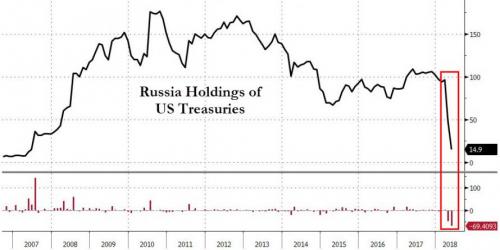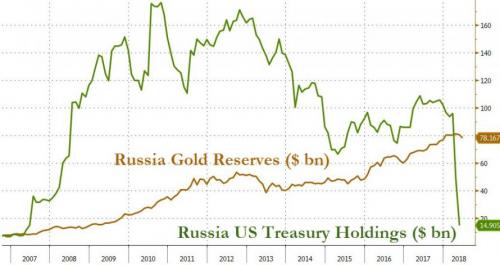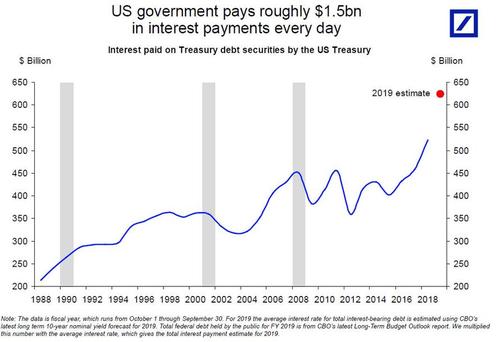London: Mountain of US Debt
There is considerable tension in US equity markets. Interest rates are rising while corporate debt in the United States has ballooned. Executives have leveraged balance sheets so that less than 10 of the S&P 500 companies now have positive cash positions. Meanwhile, the US government continues to borrow with gay abandon, and despite nearly 10 years of uninterrupted economic growth, the size of the US debt mountain is higher than ever. Unfortunately, it will become ever harder to service this debt as interest rates rise and as the historical overseas buyers begin to question the logic of funding Uncle Sam’s overdraft.
It is reported that the US will have borrowed over $1.3trillion in 2018 and the cost per day to service itscurrent debt burden is now running at $1.5 Billion a day (Figure 1).
Figure 1: Source https://www.zerohedge.com/news/2018-10-29/americas-true-deficit-us-borrow-over-13-trillion-2018
Economic power shifting
Given we are seeing a potential trade war with the US and China and increased sanctions imposed on Iran, Venezuela and Russia, how long will it be before we see other countries following the lead set by Venezuela? Venezuela recently launched the Petro crypto coin as a way to try and raise capital for its cash-starved economy. While it may have seemed like a crazy idea a year ago, how difficult would it be for a country like Saudi Arabia to do what Venezuela has done and launch a Saudi coin backed by its substantial oil reserves? Back in the 1970s, the US struck a deal for oil in exchange for US dollar power. They told the Saudis if they priced oil in US$, then used their surplus US dollars to buy US Treasury bonds, then the US would provide military protection and the Saudis could keep control of their oil reserves. Nearly 50 years later and the world is a different place. In a dynamic global marketplace where economic power is shifting, is this deal still as attractive? In 2014 oil accounted for 90% of Saudi’s revenue but by 2035 they intend to cut their government deficit to zero and their reliance on oil. One suspects there are a number of countries who would be happy not to have to buy and sell oil priced in US$, but by doing so, it would surely put further pressure on the US$.
US sanctions may backfire
With over 40% of the US bonds (i.e. their debts) held by overseas investors, American sanctions in various countries could backfire. Countries like Russia have been selling their US Treasury holding as the charts (Figure 2) show and they have been steadily increasing their holdings in gold.


Figure 2: Source https://www.zerohedge.com/news/2018-07-27/putin-plays-down-russias-dollar-liquidation-we-need-minimize-risks
Russian President Vladimir Putin said recently about sanctions imposed by the US: “I think that is a major strategic mistake because they’re undermining confidence in the dollar as a reserve currency.”
Nothing lasts forever
Concerns over the future of the US$ are not just being expressed by foreign countries, but also by the largest fund management company in the world. Larry Fink, CEO of Blackrock, while talking at the New Economic Forum in Singapore said “the US risked undermining the US$ reserve status and being the dominant currency would not last forever”.
While the US uses sanctions as a way to exert influence and control events, in our increasingly digital global economy, old regional and geographic borders become less and less significant as capital can be moved literally at the press of a button
America’s economic importance in modern times has to a great extent been based on the use and power of its currency. Great Britain’s Sterling held such status as the global reserve currency from 1815 to 1920. Before this it was the French Franc in the Napoleonic period of 1720 to 1815. Before that it was the Dutch currency from 1640 to 1720. All these currencies ultimately gave way to a new currency and typically after 100 years. The US$ has been the global reserve currency since 1920 i.e. 100 years—nothing lasts forever.
A new order
Interestingly, in a speech this November, Putin said “that the world will look for alternative payment systems…because the volatility of dollar transactions makes many economies around the world want to find alternative reserve currencies and create payment systems that are not dependent on the dollar…the world will look for alternative payment systems.”
While he was not explicit and did not mention cryptocurrencies, using language like “alternative reserve currencies, payment systems, alternative savings and transaction methods” one cannot help think that Putin is watching the Venezuelan Petro with considerable interest. Surely Putin would love to find a way to get around US sanctions and allow Russian companies to access capital and expand Russia’s economy.
It is not just Russia which is selling US Treasury bonds, but the two largest foreign holders of US bonds, China and Japan have been reducing the amount of US debt they own. This could spread as a contagion. Though this is no surprise as US interest rates rise and the value of the bonds fall—to reflect the increase in interest rates—but it is concerning. Rising interest rates usually put pressure on equity markets as it becomes harder for organisations to service their debt payments. Investors then demand higher interest rates to compensate for potential defaults and a vicious cycle kicks in. In an increasingly globally connected world, contagion and a loss of confidence can spread very quickly as we saw in 1987 and again in 2008.
Interestingly, we have seen two recent examples of major companies exploring alternatives to traditional currencies. In Russia, Nornickel, one of the world’s largest producers of nickel, are looking at launching a Stablecoin backed by the metals it produces. Companies with the credibility, resources and global footprint like Nornickel will increasingly look for alternative ways to get access to finance especially if US sanctions continue. Meanwhile, other companies like the Japanese shipping giant NYK are currently exploring how it can pay its staff globally with an NYK coin as opposed to paying them in Yen.
A new asset class
If we are to see a greater adoption of cryptocurrencies, the whole user experience needs to be made more user friendly and secure. Governments will require KYC and AML checks to ensure cryptocurrencies do not become the preferred way for money laundering and other nefarious activities moving money around undetected. However, as we start to see trusted global brands like Sony from Japan offering cryptocurrency wallets, more and more institutions will be encouraged to become more engaged, and gradually we may see a move away from traditional currencies like the US$ for day-to-day transactions.
In the last 100 years in times of economic uncertainty, the US$ has been a safe haven and investors have sold equities and bonds and often held cash in the US$. However, when we have the next big economic shock and an equity market correction, there is now an alternative to holding a heavily debt-laden investment that the US$ has become. We may see investors looking to divert capital to cryptocurrencies which have been uncorrelated to other asset classes. This may explain why we are seeing more institutions showing interest in this sector like Fidelity who have $6.8 Trillion under administration and have recently announced they are looking at expanding the number of cryptocurrencies that they offer custody services to institutions. It is not just Fidelity who are active, Binance, the largest crypto exchange operator believes that stablecoins will be a sizeable market as they launch a platform to trade these assets.
Cryptocurrencies backed by tangible assets offer a viable alternative. Historically, many currencies have been backed by gold as the US$ was since 1800 when the gold standard for US$ was introduced. Potentially, investors in cryptocurrency will have a far greater selection as to where to invest and will have exposure to different assets, whether that be commodities, diamonds, palladium, nickel, crude oil, real estate, or rare collectables—potentially a Stradivarius violin—all available via digital, globally tradeable cryptocurrencies.
The US$ continues to be the global reserve currency for now. But with a combination of a mountain of US government and corporate debt, rising interest rates, monetary and economic sanctions and now a new alternative asset class in the form of cryptocurrencies, one wonders for how much longer.
Jonny Fry is CEO, TeamBlockchain Ltd

